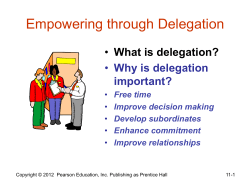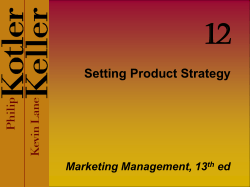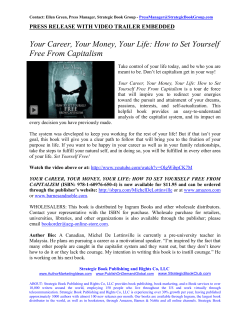
Modern Systems Analysis and Design Chapter 6 Determining System
Modern Systems Analysis and Design Seventh Edition Jeffrey A. Hoffer Joey F. George Joseph S. Valacich Chapter 6 Determining System Requirements Learning Objectives Describe options for designing and conducting interviews and develop a plan for conducting an interview to determine system requirements. Explain the advantages and pitfalls of observing workers and analyzing business documents to determine system requirements. Explain how computing can provide support for requirements determination. Participate in and help plan a Joint Application Design session. Chapter 6 Copyright © 2014 Pearson Education, Inc. Publishing as Prentice Hall 2 Learning Objectives (Cont.) Use prototyping during requirements determination. Describe contemporary approaches to requirements determination. Understand how requirements determination techniques apply to the development of electronic commerce applications. Chapter 6 Copyright © 2014 Pearson Education, Inc. Publishing as Prentice Hall 3 Performing Requirements Determination FIGURE 6-1 Systems development life cycle with analysis phase highlighted Chapter 6 Copyright © 2014 Pearson Education, Inc. Publishing as Prentice Hall 4 The Process of Determining Requirements Good Systems Analyst Characteristics: Impertinence—question everything Impartiality—consider all issues to find the best organizational solution Relax constraints—assume anything is possible Attention to details—every fact must fit Reframing—challenge yourself to new ways Chapter 6 Copyright © 2014 Pearson Education, Inc. Publishing as Prentice Hall 5 Deliverables and Outcomes Deliverables for Requirements Determination: From interview transcripts, observation notes, meeting minutes From Chapter 6 existing written documents mission and strategy statements, business forms, procedure manuals, job descriptions, training manuals, system documentation, flowcharts From interviews and observations computerized sources Joint Application Design session results, CASE repositories, reports from existing systems, displays and reports from system prototype Copyright © 2014 Pearson Education, Inc. Publishing as Prentice Hall 6 Traditional Methods for Determining Requirements Interviewing individuals Interviewing groups Observing workers Studying business documents Chapter 6 Copyright © 2014 Pearson Education, Inc. Publishing as Prentice Hall 7 Interviewing and Listening One of the primary ways analysts gather information about an information systems project An interview guide is a document for developing, planning and conducting an interview. Chapter 6 Copyright © 2014 Pearson Education, Inc. Publishing as Prentice Hall 8 Guidelines for Effective Interviewing Plan the interview. Prepare interviewee: appointment, priming questions. Prepare agenda, checklist, questions. Listen carefully and take notes (tape record if permitted). Review notes within 48 hours. Be neutral. Seek diverse views. Chapter 6 Copyright © 2014 Pearson Education, Inc. Publishing as Prentice Hall 9 Interviewing and Listening (Cont.) FIGURE 6-2 Typical interview guide Chapter 6 Copyright © 2014 Pearson Education, Inc. Publishing as Prentice Hall 10 Interviewing and Listening (Cont.) FIGURE 6-2 Typical interview guide (cont.) Chapter 6 Copyright © 2014 Pearson Education, Inc. Publishing as Prentice Hall 11 Choosing Interview Questions Each question in an interview guide can include both verbal and non-verbal information. Open-ended questions: questions that have no prespecified answers Closed-ended questions: questions that ask those responding to choose from among a set of specified responses Chapter 6 Copyright © 2014 Pearson Education, Inc. Publishing as Prentice Hall 12 Interviewing Guidelines Don’t phrase a question in a way that implies a right or wrong answer. Listen very carefully. Type interview notes within 48 hours after the interview. Don’t set expectations about the new system unless you know these will be deliverables. Seek a variety of perspectives from the interviews. Chapter 6 Copyright © 2014 Pearson Education, Inc. Publishing as Prentice Hall 13 Interviewing Groups Drawbacks Chapter 6 to individual interviews: Contradictions and inconsistencies between interviewees Follow-up discussions are time consuming New interviews may reveal new questions that require additional interviews with those interviewed earlier Copyright © 2014 Pearson Education, Inc. Publishing as Prentice Hall 14 Interviewing Groups (Cont.) Interviewing several key people together Advantages More effective use of time Can hear agreements and disagreements at once Opportunity for synergies Disadvantages Chapter 6 More difficult to schedule than individual interviews Copyright © 2014 Pearson Education, Inc. Publishing as Prentice Hall 15 Nominal Group Technique (NGT) A facilitated process that supports idea generation by groups Process Members come together as a group, but initially work separately. Each person writes ideas. Facilitator reads ideas out loud, and they are written on a blackboard or flipchart. Group openly discusses the ideas for clarification. Ideas are prioritized, combined, selected, reduced. Used to complement group meetings or as part of JAD effort Chapter 6 Copyright © 2014 Pearson Education, Inc. Publishing as Prentice Hall 16 Directly Observing Users Direct Observation Watching users do their jobs Used to obtain more firsthand and objective measures of employee interaction with information systems Can cause people to change their normal operating behavior Time-consuming and limited time to observe Chapter 6 Copyright © 2014 Pearson Education, Inc. Publishing as Prentice Hall 17 Analyzing Procedures and Other Documents Document Analysis Review of existing business documents Can give a historical and “formal” view of system requirements Chapter 6 Copyright © 2014 Pearson Education, Inc. Publishing as Prentice Hall 18 Analyzing Procedures and Other Documents (Cont.) Types of information to be discovered: Problems with existing system Opportunity to meet new need Organizational direction Names of key individuals Values of organization Special information processing circumstances Reasons for current system design Rules for processing data Chapter 6 Copyright © 2014 Pearson Education, Inc. Publishing as Prentice Hall 19 Analyzing Procedures and Other Documents (Cont.) Useful document: Written work procedure For an individual or work group Describes how a particular job or task is performed Includes data and information used and created in the process Chapter 6 Copyright © 2014 Pearson Education, Inc. Publishing as Prentice Hall 20 Analyzing Procedures (Cont.) FIGURE 6-3 Example of a procedure Chapter 6 Copyright © 2014 Pearson Education, Inc. Publishing as Prentice Hall 21 Analyzing Procedures (Cont.) FIGURE 6-3 Example of a procedure (cont.) Chapter 6 Copyright © 2014 Pearson Education, Inc. Publishing as Prentice Hall 22 Analyzing Procedures and Other Documents (Cont.) Potential Problems with Procedure Documents: May involve duplication of effort May have missing procedures May be out of date May contradict information obtained through interviews Chapter 6 Copyright © 2014 Pearson Education, Inc. Publishing as Prentice Hall 23 Analyzing Procedures and Other Documents (Cont.) Formal Systems: the official way a system works as described in organizational documentation (i.e. work procedure) Informal Systems: the way a system actually works (i.e. interviews, observations) Chapter 6 Copyright © 2014 Pearson Education, Inc. Publishing as Prentice Hall 24 Analyzing Procedures and Other Documents (Cont.) Useful document: Business form Used for all types of business functions Explicitly indicates what data flow in and out of a system and data necessary for the system to function Gives crucial information about the nature of the organization Chapter 6 Copyright © 2014 Pearson Education, Inc. Publishing as Prentice Hall 25 Analyzing Procedures and Other Documents (Cont.) FIGURE 6-4 An invoice form from Microsoft Excel Chapter 6 Copyright © 2014 Pearson Education, Inc. Publishing as Prentice Hall 26 Analyzing Procedures and Other Documents (Cont.) Useful document: Report Primary output of current system Enables you to work backwards from the report to the data needed to generate it Useful document: Description of current information system Chapter 6 Copyright © 2014 Pearson Education, Inc. Publishing as Prentice Hall 27 Analyzing Procedures and Other Documents (Cont.) Chapter 6 Copyright © 2014 Pearson Education, Inc. Publishing as Prentice Hall 28 Contemporary Methods for Determining System Requirements Joint Application Design (JAD) Brings together key users, managers, and systems analysts Purpose: collect system requirements simultaneously from key people Conducted off-site Group Support Systems Facilitate sharing of ideas and voicing of opinions about system requirements Chapter 6 Copyright © 2014 Pearson Education, Inc. Publishing as Prentice Hall 29 Contemporary Methods for Determining System Requirements (Cont.) CASE tools Used to analyze existing systems Help discover requirements to meet changing business conditions System prototypes Iterative development process Rudimentary working version of system is built Refine understanding of system requirements in concrete terms Chapter 6 Copyright © 2014 Pearson Education, Inc. Publishing as Prentice Hall 30 Joint Application Design (JAD) Intensive group-oriented requirements determination technique Team members meet in isolation for an extended period of time Highly focused Resource intensive Started by IBM in 1970s Chapter 6 Copyright © 2014 Pearson Education, Inc. Publishing as Prentice Hall 31 JAD (Cont.) FIGURE 6-6 Illustration of the typical room layout for a JAD Source: Based on Wood and Silver, 1995. Chapter 6 Copyright © 2014 Pearson Education, Inc. Publishing as Prentice Hall 32 JAD (Cont.) JAD Participants: Session Leader: facilitates group process Users: active, speaking participants Managers: active, speaking participants Sponsor: high-level champion, limited participation Systems Analysts: should mostly listen Scribe: record session activities IS Staff: should mostly listen Chapter 6 Copyright © 2014 Pearson Education, Inc. Publishing as Prentice Hall 33 JAD (Cont.) End Result Documentation detailing existing system Features of proposed system Chapter 6 Copyright © 2014 Pearson Education, Inc. Publishing as Prentice Hall 34 CASE Tools During JAD Upper CASE tools are used Enables analysts to enter system models directly into CASE during the JAD session Screen designs and prototyping can be done during JAD and shown to users Chapter 6 Copyright © 2014 Pearson Education, Inc. Publishing as Prentice Hall 35 Using Prototyping During Requirements Determination Quickly converts requirements to working version of system Once the user sees requirements converted to system, will ask for modifications or will generate additional requests Chapter 6 Copyright © 2014 Pearson Education, Inc. Publishing as Prentice Hall 36 Using Prototyping During Requirements Determination (Cont.) Figure 6-7 The prototyping methodology (Source: Based on “Prototyping: The New Paradigm for Systems Development,” by J. D. Naumann and A. M. Jenkins, MIS Quarterly 6(3): 29–44.) Chapter 6 Copyright © 2014 Pearson Education, Inc. Publishing as Prentice Hall 37 Using Prototyping During Requirements Determination (Cont.) Most useful when: User requests are not clear. Few users are involved in the system. Designs are complex and require concrete form. There is a history of communication problems between analysts and users. Tools are readily available to build prototype. Chapter 6 Copyright © 2014 Pearson Education, Inc. Publishing as Prentice Hall 38 Using Prototyping During Requirements Determination (Cont.) Drawbacks Tendency to avoid formal documentation Difficult to adapt to more general user audience Sharing data with other systems is often not considered Systems Development Life Cycle (SDLC) checks are often bypassed Chapter 6 Copyright © 2014 Pearson Education, Inc. Publishing as Prentice Hall 39 Radical Methods for Determining System Requirements Business Process Reengineering (BPR): search for and implementation of radical change in business processes to achieve breakthrough improvements in products and services Chapter 6 Copyright © 2014 Pearson Education, Inc. Publishing as Prentice Hall 40 Radical Methods for Determining System Requirements (Cont.) Goals Reorganize complete flow of data in major sections of an organization. Eliminate unnecessary steps. Combine steps. Become more responsive to future change. Chapter 6 Copyright © 2014 Pearson Education, Inc. Publishing as Prentice Hall 41 Identifying Processes to Reengineer Key business processes Structured, measured set of activities designed to produce specific output for a particular customer or market Focused on customers and outcome Same techniques as requirements determination are used Chapter 6 Copyright © 2014 Pearson Education, Inc. Publishing as Prentice Hall 42 Disruptive Technologies Information technologies must be applied to radically improve business processes. Disruptive technologies are technologies that enable the breaking of long-held business rules that inhibit organizations from making radical business changes. Chapter 6 Copyright © 2014 Pearson Education, Inc. Publishing as Prentice Hall 43 Disruptive Technologies (Cont.) Chapter 6 Copyright © 2014 Pearson Education, Inc. Publishing as Prentice Hall 44 Requirements Determination using Agile Methodologies Continual user involvement Replace traditional SDLC waterfall with iterative analyze–design–code–test cycle Agile usage-centered design Focuses on user goals, roles, and tasks The Planning Game Based on eXtreme programming Exploration, steering, commitment Chapter 6 Copyright © 2014 Pearson Education, Inc. Publishing as Prentice Hall 45 Continual User Involvement FIGURE 6-9 The iterative analysis–design–code–test cycle Chapter 6 Copyright © 2014 Pearson Education, Inc. Publishing as Prentice Hall 46 Agile Usage-Centered Design Steps Gather group of programmers, analysts, users, testers, facilitator. Document complaints of current system. Determine important user roles. Determine, prioritize, and describe tasks for each user role. Group similar tasks into interaction contexts. Associate each interaction context with a user interface for the system, and prototype the interaction context. Step through and modify the prototype. Chapter 6 Copyright © 2014 Pearson Education, Inc. Publishing as Prentice Hall 47 The Planning Game from eXtreme Programming FIGURE 6-10 eXtreme Programming’s Planning Game Chapter 6 Copyright © 2014 Pearson Education, Inc. Publishing as Prentice Hall 48 Electronic Commerce Applications: Determining System Requirements Determining system requirements for Pine Valley furniture’s WebStore System layout and navigation characteristics WebStore and site management system capabilities Customer and inventory information System prototype evolution Chapter 6 Copyright © 2014 Pearson Education, Inc. Publishing as Prentice Hall 49 Summary In this chapter you learned how to: Describe interviewing options and develop interview plan. Explain advantages and pitfalls of worker observation and document analysis. Explain how computing can support requirements determination. Participate in and help plan Joint Application Design sessions. Chapter 6 Copyright © 2014 Pearson Education, Inc. Publishing as Prentice Hall 50 Summary (Cont.) Use prototyping during requirements determination. Describe contemporary approaches to requirements determination. Understand how requirements determination techniques apply to the development of electronic commerce applications. Chapter 6 Copyright © 2014 Pearson Education, Inc. Publishing as Prentice Hall 51 Copyright © 2014 Pearson Education, Inc. Publishing as Prentice Hall
© Copyright 2025









